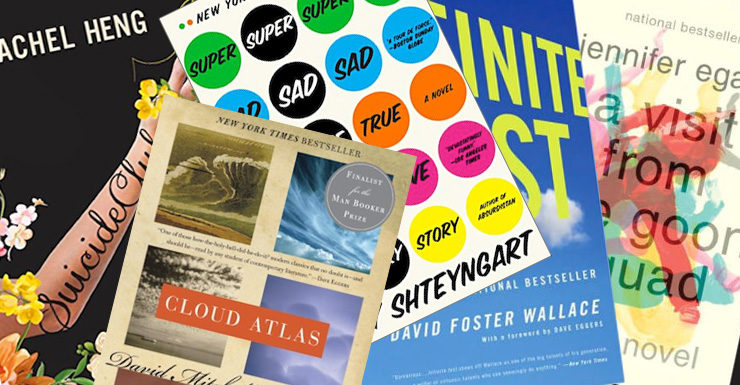It’s only natural that writers like to think about the future—after all, it’s where you and I are going to spend the rest of our lives. And obviously science fiction has given us a fantastic variety of futures, from Martian colonies to neon-lit, noir-tinged urban jungles to post-apocalyptic hellscapes. However! I thought I’d look at books from that bleak genre known as “literary fiction,” to see how the future plays out when the author has spent their careers hewing a little more closely to what passes for reality these days.
I’ve got six books so far, each giving a unique look at the world to come. Add your own literary favorite in the comments!
Infinite Jest by David Foster Wallace
Buy the Book
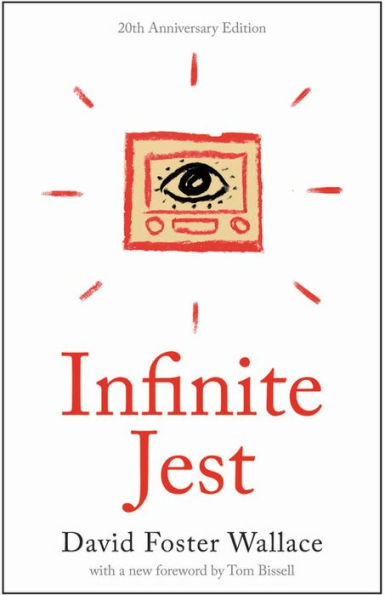

Infinite Jest
At 1, 079 pages long, David Foster Wallace’s Infinite Jest has plenty of room for worldbuilding, and uses it to the hilt. After reading that book, the near-future North America of the book felt more real than the one I was currently living in. The book’s futuristic flourishes include, but are not limited to: a future North America where the borders have moved to allow most of Quebec and a sizable chunk of New England to be turned into a toxic waste dump for the use of the United States; border trebuchets that regularly launch American garbage over said border; giant hamsters and feral babies that roam the dump in packs; a holiday, called Interdependence Day, which celebrates the forced unification of the three North American nations; people watching prerecorded entertainment on cartridges rather than broadcast television; a vaguely totalitarian government; Football players who dress as their mascots, and play at least some of the game in mid-air, with jetpacks. Most importantly, there is a film that seemingly plays on a loop that is so addictively entertaining that anyone who’s exposed to it just keeps watching it until they die…usually of dehydration. Since Wallace was more of a postmodern literary type than a sci-fi writer, all of his futurism is pretty hand-wavey—we don’t learn how the film keeps repeating, or even why it’s so effecting—the vital information, for Wallace, is the way it instantly addicts anyone who see it.
What’s even more interesting, though, is the sense of despair he weaves through a wacky, madcap book. His central idea is that people are lonelier in the future because they’ve been so drained by entertainment and the expectation of capitalism that people no longer have the capacity for true joy or connection with others. It’s pretty bleak (and exceedingly white middle-class boy) but it also creates an incredibly visceral experience of the future.
A Visit From the Goon Squad by Jennifer Egan
Buy the Book
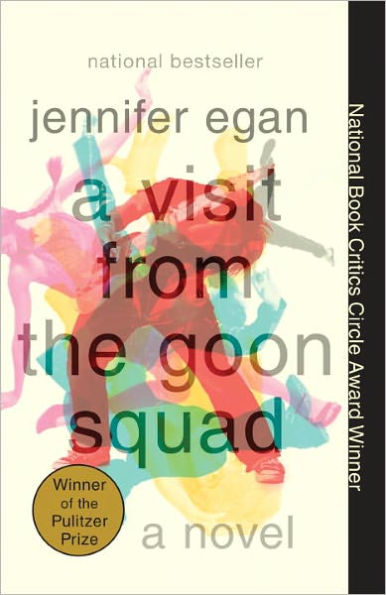

A Visit from the Goon Squad
In her Pulitzer Prize-winning collection A Visit From the Goon Squad, Egan gives us two distinct dystopian settings. Set about 15 years after the book’s publication—roughly 2025—she takes us first to the desert and then to Manhattan, giving us two different views of the near future.
Out in the desert, former glamorous music industry insider Sasha (whom we follow throughout the interconnected stories of the book) has married and had two children. Her daughter Alison narrates the story, titled “Great Rock and Roll Pauses by Alison Blake.” The story, which you can read in its entirety here, was widely praised when it came out because it’s told as a series of PowerPoint slides. It’s supposed to be a school presentation, but Alison uses the format to talk about her family, especially life with her autistic brother, and as the slides flick along a very clear piece of worldbuilding comes into view. Alison is simply describing the world she lives in, but we here in the present can see that Alison lives in a world where the economy never recovered from the 2008 crash. Climate change is drastically worse, and her family, like most families, uses solar cells to power their lives.
The final story in the collection, “Pure Language,” takes place the same year, but hops back to Manhattan. The seasons are out of whack, as trees are now blooming in January, and a wall encircles New York to keep rising water levels at bay, and helicopters patrol the city, guarding against another terrorist attack. The U.S. has been at war with various enemies continuously for 20 years. Alex, a minor character earlier in the novel, is now trying to stay in the music business and navigate a shifting youth culture. Egan’s youth culture has rejected the piercing and tattoos of their Gen X parents, social media has grown into more powerful and omnipresent version of the Facebook and Instagram pages we have now, and everyone markets themselves, continuously, through photos and updates on their social media pages. We meet Lulu, an early twenty-something who has replaced Sasha at a music production company. “She was ‘clean’: no piercings, tattoos, or scarifications. All the kids were now.” The kids also don’t swear, swapping out words like shucks and golly that their square great-grandparents had used. We learn that Lulu has taken three semesters of physics for her marketing degree, because in a post-viral world, people desire a simultaneous influence called “reach” that requires a knowledge of string theory to pull off. Your “reach” defines how successful you are. The old Boomer and Gen X concepts of “selling out” and “buying in” have both been rendered moot in this future, where college students believe that both are the result of “atavistic purism” a dedication to an ideal of morality that never existed, can’t exist, and is used as a weapon of coolness. Lulu’s generation is more comfortable texting in short, vowel-less bursts, and sending gifs to each other, because the idea has taken hold that verbal speech, with its metaphors and nuance, allows too many opportunities for embarrassment or offense.
This might seem a little like an older person’s op-ed about Kids Today, And Their Hatred of Mayonnaise, but Egan makes it work in tandem with the previous story to create a vision of a future still dragging itself out of an economic collapse, and a collapse of ethics, that are both playing out in an environment that can’t possibly sustain humanity much longer. The language has also changed, with academics now writing papers on “word casings”—words that were now empty and meaningless to the young generation. These words include “friend” and “identity.”
Super Sad True Love Story by Gary Shteyngart
Buy the Book
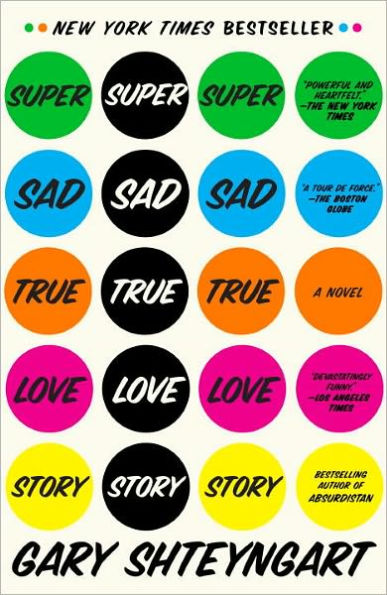

Super Sad True Love Story
The private mental ratings of Egan’s characters seem like a quaint old-fashioned notion compared with Super Sad True Love Story. Gary Shteyngart creates a claustrophobic world in which people’s credit score are broadcast over transmitter towers that read their Äppärät as they walk past. Your Äppärät also broadcasts your attractiveness rating, women wear translucent onionskin jeans that are as tight as possible. People can get degrees in “media” all social media feeds have been replaced by GlobalTeen, which handles your public profile, your emails, your text, everything. The smell of books is considered…not offensive, exactly, but like if someone opened a particularly strong-smelling food on an airplane. Youth is prized above all else, and New York’s middle-aged community does everything they can to replace fluids and juggle surgeries to look younger. In this world, Lenny Abramov is an anomaly who loves greasy Italian food and collects old paperbacks, but the only way to stay employed and keep his credit rating up is to pursue youth the same way everyone else does. His existential crisis and romance with a much-younger Korean-American woman play out against an American economy in freefall, rampant homelessness, and finally a battle between the totalitarian US government (locked in a war with Venezuela) and an attempted socialist uprising (who probably don’t have the manpower for a coup).
The overall effect of the book is just a sense of desperation that becomes as powerful, in its way, as what Cormac McCarthy achieved in The Road. Everyone is in such desperate, horrifying chase for youth that they can’t allow themselves to enjoy anything in the moment, and any hope of attaining wisdom is impossible. Most of all is the basic sense that there is no center to society. Everyone spends the vast majority of their time shopping, but US currency is worth less and less. People only want jobs in Retail and Media, but no one is producing any interesting art, so what is there for the Media to report on? Everyone wants to be young…but there are only so many times transfusions and surgery will work before you begin to look your age. The despair waits just at the edge of all the book’s bleak humor.
Suicide Club by Rachel Heng
Buy the Book


Suicide Club
This idea is taken to an even more gruesome extreme in Rachel Heng’s Suicide Club. In a future where medical advances mean you can live to be at least 300 years old, everyone strives to be the healthiest, the glowiest, the most youthful, the most life-loving. But as the book unfold, its characters don’t seem to enjoy their lives at all. New York has been subdivided into a number of boroughs, including the current five but seemingly stretching well out onto Long Island. Wealthy Lifers crowd together, wanting to be close to their clinics, but also close to each other as a psychological salve in the face of a plummeting birthrate. Sub-100s, those who are tested at birth and found to be genetically inferior and thus ineligible for life extension, live in the Outer Boroughs, further and further out. Meanwhile, huge swathes of the U.S. are simply empty, with whole towns abandoned when sub-100s died off, or Lifers crowded into cities like Boston and Chicago to be closer to the medical maintenance they need.
Undergirding everything is a churning desperation as characters try to fill their time without ever being too excited, or too happy, or too…anything. Film, television, and videogames are all looked on as barbaric and overstimulating. Music is frowned upon, having been replaced by recordings of soothing nature sounds like rainfall or birdsong. Painting is seen as a nigh-deviant activity. And obviously eating meat or sugar, or indulging in alcohol, are seen as forms of insanity. As healthy living begins to seem increasingly oppressive, Heng asks the question: what’s the point of living 300 years if you only enjoy the first 20?
Cloud Atlas and The Bone Clocks by David Mitchell
Buy the Book
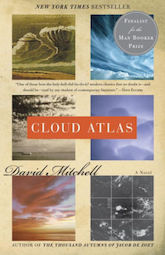

Cloud Atlas
David Mitchell is considered a solidly literary fiction writer, but his books take place in one giant interconnected world, which was directly inspired by his obsessive reading of Tolkien. As a result, most of his work ties together in interesting ways, with characters and in-world works of art cropping up in multiple books, or the descendants, or even later incarnations, of characters playing out conflicts over and over across centuries.The two books that venture furthest into the future are Cloud Atlas, a long meditation on what happens when the powerful get to define—or deny—the humanity of the weak, and The Bone Clocks is a much more fantastical book that looks at how humans interact with their environment and their mortality.
Cloud Atlas is one giant, century-spanning story, told over a series of linked novellas that take on a unique shape: each one is halved, so the first part of each story flows into the first part of the next. They guide the reader through the decades, beginning on a South Seas voyage in the 1850s where things are not as they seem, up to a 22nd Century South Korea where clones are used as enslaved laborers, and ending with the book’s first peak, a complete novella that takes place about one hundred years in our future, after a total societal collapse. Then the book cascades back through the centuries with the second half of each story in reverse order, until it ends where it began, with a seafaring adventure in the 1850s. The unusual structure allows the book multiple endings, but it also places the far future and near future in context with the “present day” and “past” chapters, undercutting the urge to label them as “sci-fi” or “historical fiction, and gently poking the reader for thinking that their era is somehow special. His later novel, The Bone Clocks, attacks time in a linear fashion, but lopes through the second half of the 20th century, and well into the 21st, with alarming speed. Before you know it, you’ve arrived at the threshold of the future predicted in Cloud Atlas. This makes for an excellent framing device to look at how Mitchell constructs a future, because it makes it feel extremely real.
This is not a good thing.
Buy the Book
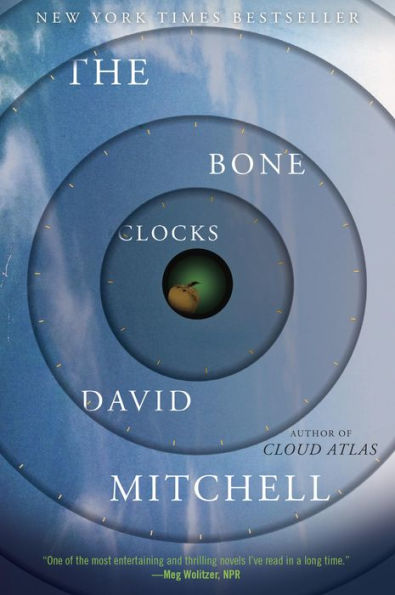

The Bone Clocks
In The Bone Clocks we visit a village in Ireland that has gone through the Endarkenment—a climate-change-fueled collapse into a post-oil, pre-industrial state. It’s been going OK for a few years, with a stable-ish China supporting Ireland with oil, and locals cobbling together a life of communal farming supplemented with some government rations. But now an entire generation is growing up without the civilizing influence of, um, civilization, and as the young men of the village age into manhood, they see that it’s much easier to take what they want than to play by an earlier generation’s rules. As the older people realize that things are only going to get worse, they realize it’s easier to shore their authority up with fundamentalist religion and fearmongering than to adhere to old ideas about science and technology. What has science done for them, anyway? Back in Cloud Atlas, we learn that another result of the Endarkenment was “The Skirmishes” a global resource war that left most of the world a ruin. One of the regions spared, Nea So Copros, is a totalitarian state in current Korea where people have created and enslaved a race of clones. These “fabricants” are mistreated just as cruelly as the enslaved have always been treated, and the story follows a clone called Sonmi~451 as she learns about her place in the world. This future is candy-colored and lovely on the surface, but the upper echelons of society ignore the underclass they’ve created, and ignore their own waste and materialism.
Then in Cloud Atlas’ central novella, “Sloosha’s Crossin’ an’ Ev’rythin’ After,” we see that this slide has become the norm. Humans huddle around firelight swapping stories about their goddess Sonmi about Ol’ Georgie, a post-apocalyptic version of the Christian Devil. People are hunters and gatherers for the most part, and any weirdness or curiosity is feared, but even here Mitchell insists that tiny acts of hope can echo out into the world and pull humanity toward a brighter future.










